Wolf spiders are some of the largest spiders in Michigan. Often confused with tarantulas, these spiders impress with their hunting abilities. There are many types of Wolf spiders in Michigan, each with distinct characteristics.
These spiders don’t construct spider webs. They hunt and look for prey while on the move. This makes these spiders special.
Table of Contents
What Are Wolf Spiders?
Wolf spiders are hairy Lycosids that are highly common in Michigan. These aren’t dangerous spiders to humans as they have low aggressiveness. However, they can bite when threatened. Wolf spiders normally hunt for small insects and other small spiders in Michigan.
Often found in gardens and lawns throughout the state, Wolf spiders often live in burrows and under leaves. They either wait or move around for insects and other spiders in the area.
Most Wolf spiders in the state are characterized by grey, brown, and yellow coloration with black stripes on the body. These spiders can vary in coloration depending on their age.
The size of these spiders varies from one type of Wolf spider to another. They generally measure up to 2 inches in body length plus the length of their feet. They grow to full size rather quickly. Most Wolf spiders live between 1 and 2 years, which is a bit more compared to other small spider lifespans.
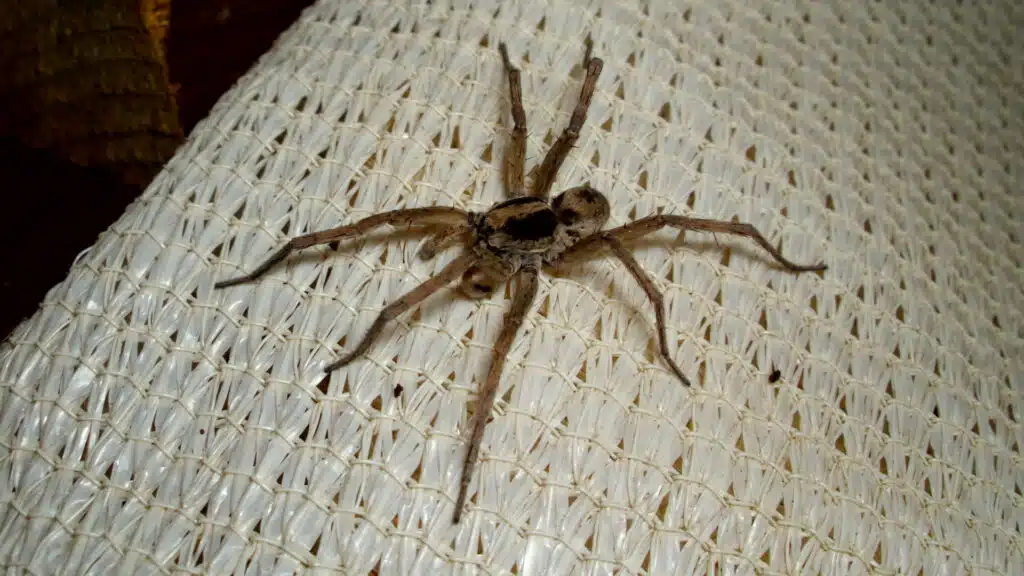
Breeding happens outside the female’s burrow. Most Wolf spiders breed at night. Male Wolf spiders make their way to female burrows by the scent these females leave behind.
Most Wolf spider bites are followed by mild symptoms or no symptoms at all. Some pain and itching can result following the bite but some people show no symptoms at all. Severe Wolf spider bites’ symptoms include dizziness and breathing difficulties.
Anti-inflammatory medication is prescribed for both too mild and severe reactions to Wolf Spider bites.
9 Types of Wolf Spiders in Michigan
There are many recorded species of Wolf spiders in Michigan. These aren’t bound by state borders and are often found in nearby states as well. However, these are the most common Wolf spiders found in Michigan.
1. Shoreline Wolf Spider
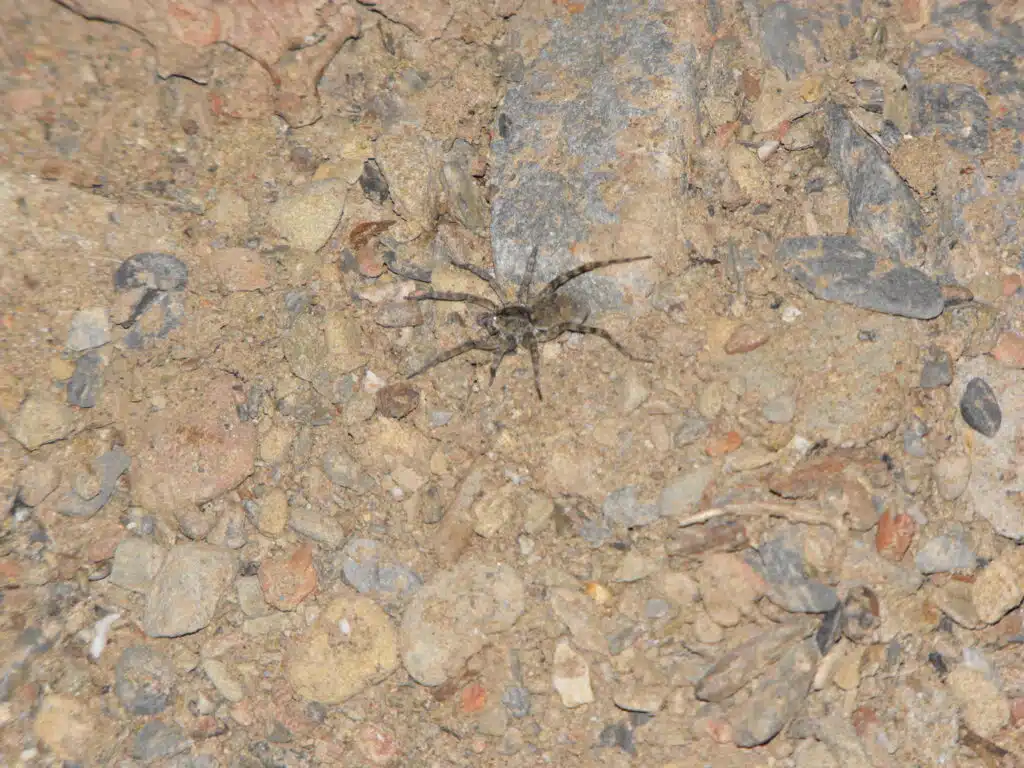
This unique Wolf spider (Arctosa littoralis) loves dunes. It leaves in various sand-rich habitats such as stream banks. Its habitat dictates its pale coloration which mimics sand. This might make it hard to spot at first, but the spider is easier to see during the night when out hunting using a flashlight.
This spider grows to a size of 11 to 15mm. It can be found under driftwood or rocks or in other small shaded areas of sand. It has specific camouflage coloration which makes it hard to spot on sand but very easy to see when it wanders off its sandy habitat.
2. Unbanded Wolf Spider
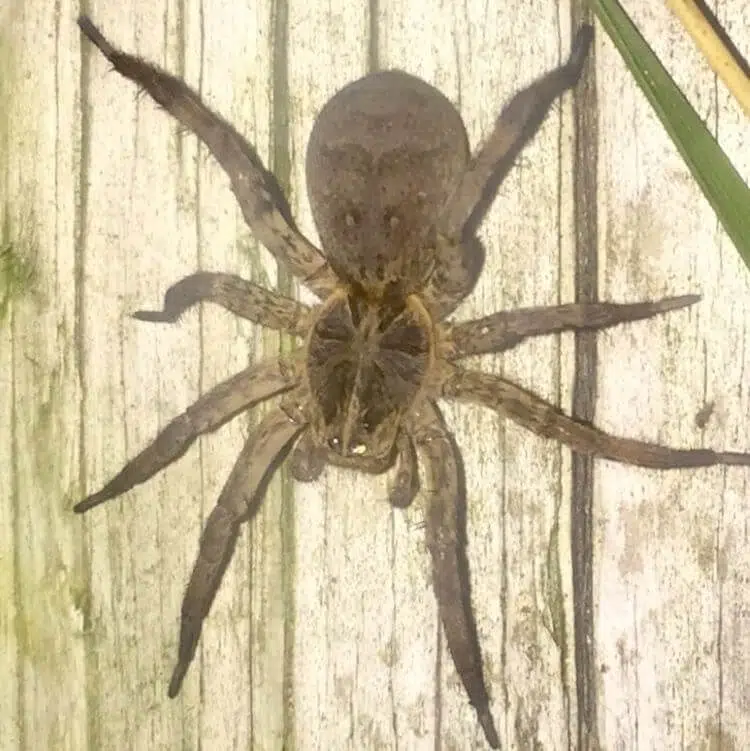
This is a species of ground spider. It makes burrows where it waits for prey. It eats crickets and waxworms among others. They have a patient hunting style which means they follow their prey carefully before making a move.
These spiders (Hogna baltimoriana) paralyze the prey with neurotoxins. They typically eat the prey on the spot. You can recognize this spider by its brown-yellow coloration with very distinct black markings both on the body and on the legs.
3. Rabid Wolf Spider
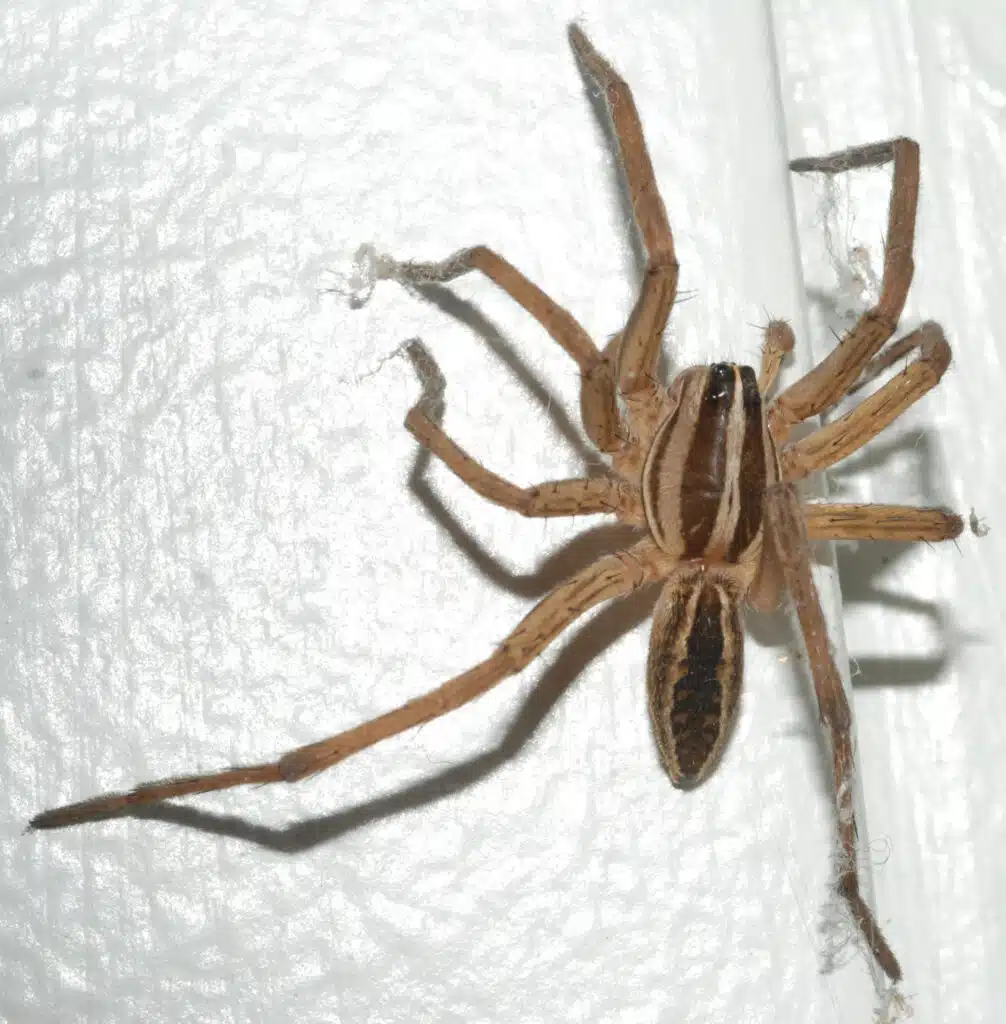
The Rabid Wolf Spider (Rabidosa rabida) is one of the Wolf spiders that is easiest to recognize in Michigan. This spider has a yellow color with hints of brown. Its light color provides very good contrasts for the black stripes on its body which makes it immediately stand out, unlike the Unbanded Wolf Spider which is harder to identify.
The spider doesn’t weave a web but it can still make silk. However, its silk is mainly used to carry eggs.
Rabid Wolf Spiders are agile creatures and their mating rituals are as complex as their ability to move around quickly. Males try to impress females by dancing.
Once mating is successful, the female Rabid Wolf Spider starts to carry the spiderlings on her back. Spiderlings are with the female until they reach adulthood.
4. Wetland Giant Wolf Spider
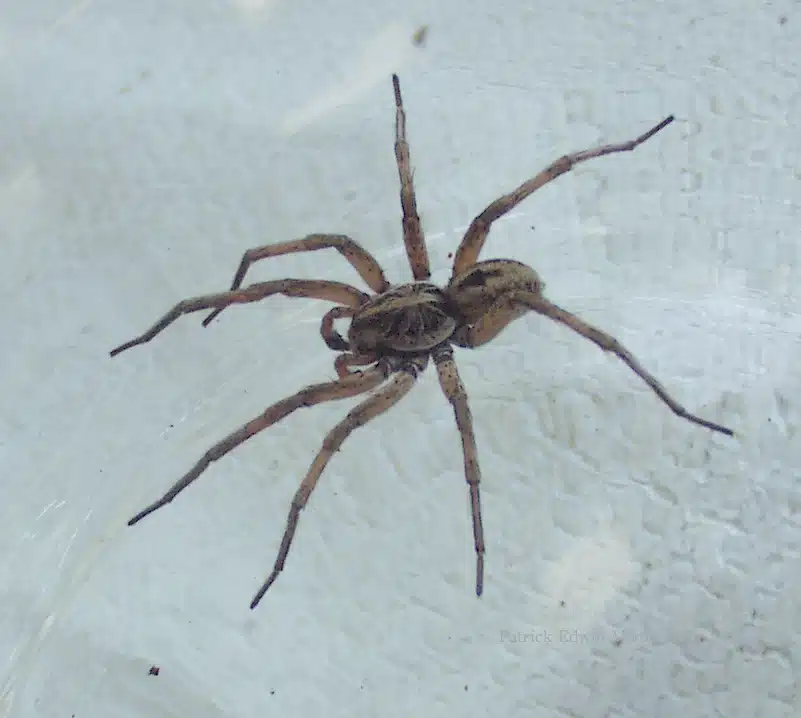
This spider (Tigrosa helluo) is also easy to recognize as the female Wetland Giant Wolf Spiders have a distinct mark on the abdomen. Unlike the Rabid Wolf Spider which lives both in wet and dry habitats, the Wetland Giant Wolf Spider prefers areas with high humidity.
This is an active hunting spider that doesn’t weave spider webs. It grows to a maximum size of 17mm and it hunts smaller prey.
Wetland Giant Wolf Spiders hunt during the night. Excellent vision and navigation senses allow them to be successful when hunting at night.
5. Drumming Sword Wolf Spider
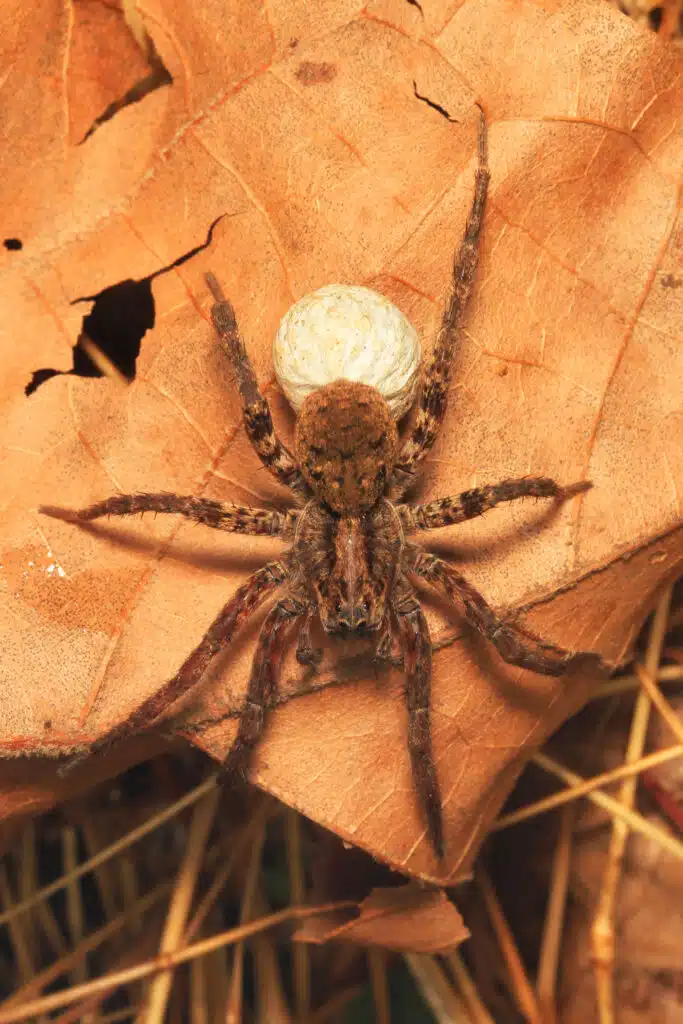
This type of Wolf spider (Gladicosa gulosa) is also common in Michigan. It can be found in ground-level plants and leaves, particularly in woodlands and gardens. It has no shelter and it prefers to move from one area to another as long as there are leaves and plants to hind behind.
It has a yellow color with black markings and it’s rarely seen out during the day.
6. Rustic Wolf Spider
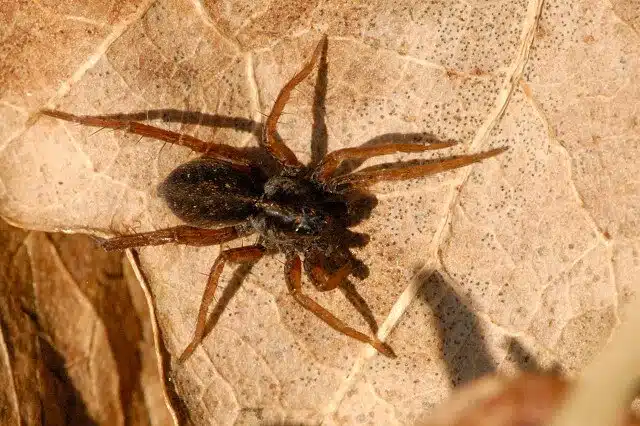
Often found in grassland, the Rustic Wolf Spider (Trochosa ruricola) appears darker than the Drumming Sword Wolf Spider. It’s also a larger species since it grows to a maximum size of 25mm.
You can recognize this spider by its yellow legs and black body with a pale yellow line that runs across the carapace.
This Wolf spider is also not as hairy as the Drumming Sword Wolf Spider and the Wetland Giant Wolf Spider.
7. Pirate Otter Spider
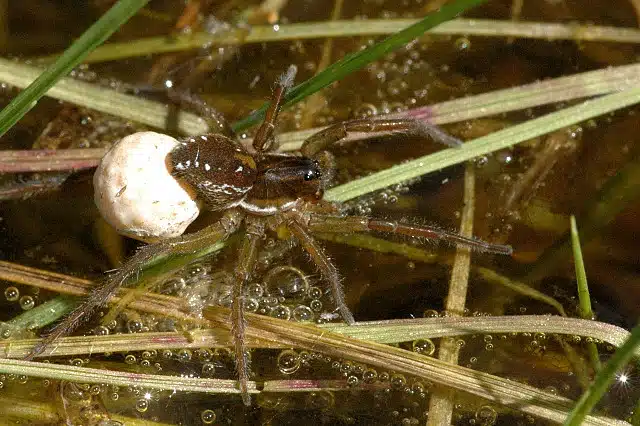
This spider (Pirata piraticus) lives around water sources as its name suggests. It’s a type of spider that is very active in hunting around water sources such as lakes and ponds. Its habitat dictates its translucent appearance and dark brown-gray body.
It’s also one of the smallest Wolf spiders in the state. The male Pirate Otter Spider grows to a length of up to 6.5mm. The female is slightly larger but still small with a length varying between 4.5 and 9mm.
8. Dotted Wolf Spider

These large fury-looking spiders (Rabidosa punctulata) get their names from their dotted yellow body with black lines. Their dots or marks are visible better when the spiders reach adulthood.
Found in areas with tall grass such as meadows and parks, this spider is also common in woodlands. Its presence has been signaled numerous times in nearby states as a clear sign that its hunting nature isn’t bound by borders.
9. Tiger Wolf Spider
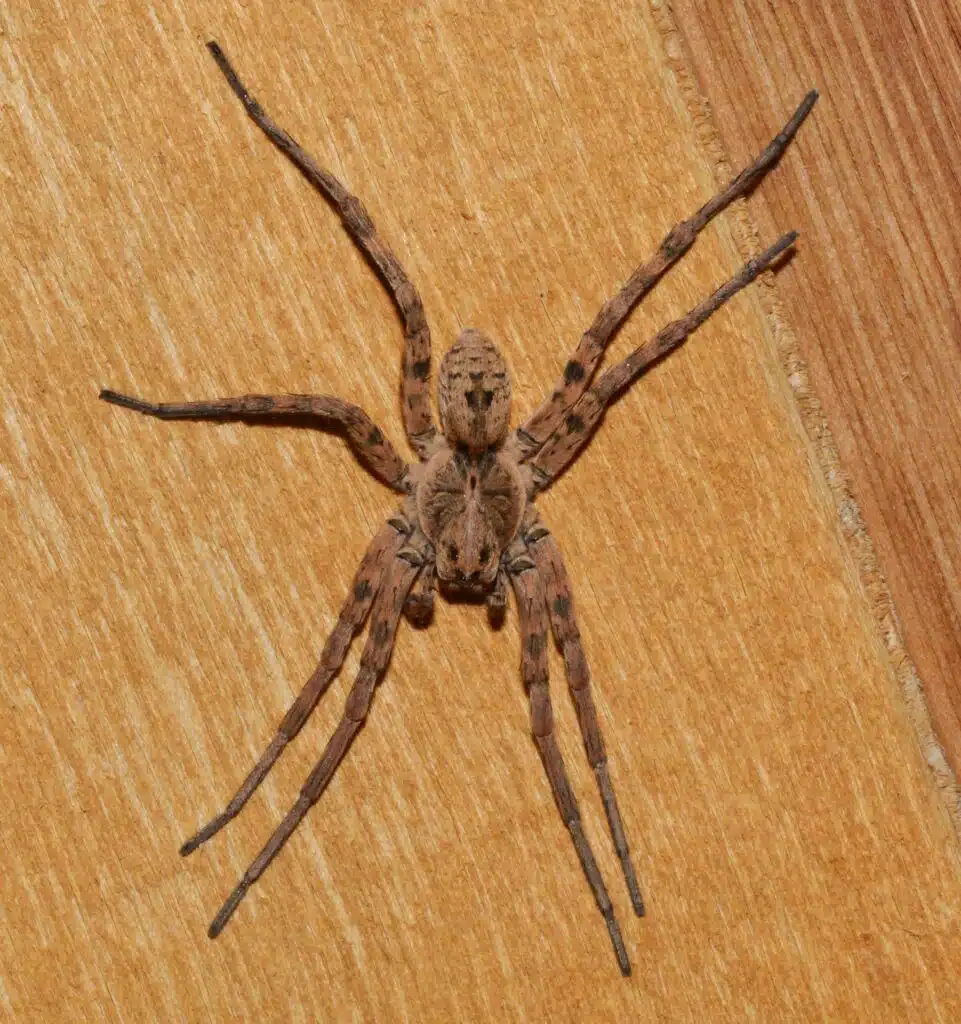
The Tiger Wolf spider (Tigrosa aspersa) is characterized by black, brown, and tan colors. It’s not to be confused with its larger Giant Tiger Wolf spider version. The spider lives on the ground in burrows. It hunts prey that passes near the burrows.
The spider is largely seen in the spring, during the mating season. However, it’s the female spiders that are seen frequently rather than the male spider, as with most Wolf spiders. You can find these spiders in man-made structures such as in the garage or garden sheds.
Are Wolf Spiders in Michigan Venomous?
It’s often a misconception to believe there are no dangerous spiders in Michigan. The state has plenty of venomous spiders such as the Black Widow or the Brown Recluse. Since these are the truly venomous spiders in the state many assume Wolf spiders aren’t venomous, which isn’t the case.
Most Wolf spiders are venomous. They inject venom when they bite. While the venom is insufficient to kill a person (not comparable to the venom of the Black Widow), it’s still potentially dangerous and requires medical attention insufficient cases. However, the venom of Michigan Wolf spiders won’t kill a person if there’s no medical care.
What to do when you are bitten by a Wolf spider
Wolf spider bites should be taken seriously, even if sometimes not painful. These bites need to be taken seriously. The first symptoms include a bump, swelling of the bite area or the face, a red line (possible blood infection), breathing difficulties, and even dizziness. Here’s what to do if bitten by a Wolf spider.
- Wash the area of the bite
The first action is to wash the area clean. This has the potential of keeping infections away. Cold fresh water and soap are ideal for cleaning the area of the bite.
- Use ice
Ice is a very handy solution to reduce inflammation and swelling. Most Wolf spider bites can be dealt with by using ice as an external anti-inflammatory instead of using over-the-counter anti-inflammatory medication. Ice can be used on its own or together with anti-inflammatory medication to control the inflammation in the area of the bite.
- Elevate the wound
If the spider bite is on the leg or the arms it can be a good time to elevate the wound. It can be one of the processes that prevent venom dissipation.
- Consider anti-inflammatory medication
Anti-inflammatory medication is sometimes part of medical Wolf spider bite medication. Sometimes it needs to be prescribed by a doctor and other times it can be bought in a local pharmacy.
- See a doctor
Seeing a doctor is ideal for a Wolf spider bite. Doctors prescribe anti-inflammatory medication and they can even keep you under observation during the treatment. It’s best to take the Wolf spider with you to the doctor to correctly identify the venom of the species.
When to Find Wolf Spiders in Michigan?
The best time to see Wolf spiders in Michigan is in the spring. This is the reproductive period of these spiders and it can be the ideal time to see both male and female spiders. Most times you see these spiders alone.
Similar to real wolves, these spiders hunt and live alone. They only get together during the mating period when the female leaves a scent for the male to follow. This is also the ideal time to see the spider.
Males perform long dances in front of the females to make an impression. The female can kill the male spider after mating. The female can also refuse to mate with the male Wolf spider.
After mating the female carries the eggs in a silk sack. There are plenty of females with spiderlings stacked on top to see during the months that follow. The little spiders remain with the female until reaching adulthood. The female moves slower when carrying the egg sack and the spiderlings, essentially meaning the spider can be seen easier.
But Wolf spiders can also be seen during the night using a flashlight. Their eyes turn green when you shine a light at night essentially giving up their location.
What to Do If You See a Wolf Spider in Michigan?
You need to catch the spider when you see one around your house. This is a priority followed by taking the right measures to ensure there are no other spiders that return to your home.
- Refrain from touching the spider
You should try not to touch the Wolf spider. Even if this isn’t a poisonous spider it might still bite. It’s best to handle these spiders with the car and using objects that put a distance between the spider and yourself is the best approach.
- Don’t squish Wolf spiders
Many people feel tempted to squish Wolf spiders. However, this can be troublesome, especially when squishing a female Wolf spider carrying spiderlings. This can release hundreds of spiderlings inside the house.
A Wolf spider can carry at least 120 spiderlings that can scatter all around the house. It’s best to refrain from squishing this spider as a result.
- Catch the spider using a sticky cardboard trap
A sticky cardboard trap is the easiest secure method of catching a Wolf spider inside the house. Ideally placed in corners and under furniture, the sticky surface catches the spider.
- Use a vacuum cleaner to catch the spider
A vacuum cleaner can also be used to catch the spider on the spot. It’s best to clear the vacuum cleaner to ensure the spider doesn’t come out into the house or next to the house.
- Scatter boric acid around the house
Boric acid is a type of insecticidal with industrial action. It causes the fluids of the spider to leak. However, white powder isn’t the safest in homes with children.
Wolf spiders can easily get inside a home. Various factors attract it to a home or the habitat around the house. Here are a few preventative measures that help keep all types of Wolf spiders out of the house.
- Eliminate insects around the house
You need to eliminate all insects in the home’s proximity if you don’t want to attract spiders. It might take a consistent effort to change all existing exterior lights to yellow lights which have been proven not to attract insects and flies.
- Clear vegetation around the home
Vegetation such as shrubs, plants, tall grass, and leaves are ideal breeding spaces for Wolf spiders. The clearer the yard is the fewer chances these spiders have to find a habitat near the house.
- Reduce moisture and humidity
Moisture is one of the essential factors that drive Wolf spiders towards the home, particularly towards the basement.
It’s not just the Wetland Giant Wolf Spider that loves moisture. Many other types of Wolf spiders are attracted to moisture as this is a good place for flies, insects, and certain mosquitoes to live. Wolf spiders hunt this prey.
- Check all doors and windows
Windows and doors are can come with small spaces Wolf spiders can use to crawl under. These are the easiest access points for the spiders in the house. They need to be sealed.
- Look for cracks in the walls and under the roof
Spiders can also enter the house using small cracks and openings. You can check the walls under the roof to seal off the space and keep spiders out. Ventilation shafts need to be sealed with a fine bug and fly net.
- Get a cat
Cats are natural predators and they can sometimes control Wolf spiders around the house. Great at pest control, cats tend to hunt for all types of small and large spiders.
Summary
Michigan is a state Wolf spiders love. There’s plenty of vegetation and food for these spiders to thrive here. Man-made structures are found all over the place as are lakes and ponds so many types of Wolf spiders love. Woodlands in the state provide an ideal hunting ground as well.
While not poisonous (the spiders are venomous), Wolf spiders can still inflict pain and even cause adverse reactions when they bite. This is why it’s best to avoid spiders at all costs.
Typical mistakes made in Michigan include confusing Wolf Spiders with the Brown Recluse.
Not clearing the house of things that attract these spiders are also frequent mistakes that attract Wolf spiders. Leftover food attracts insects Wolf spiders eat. High moisture levels, as well as puddling water around the house, attract Wolf spiders as well.